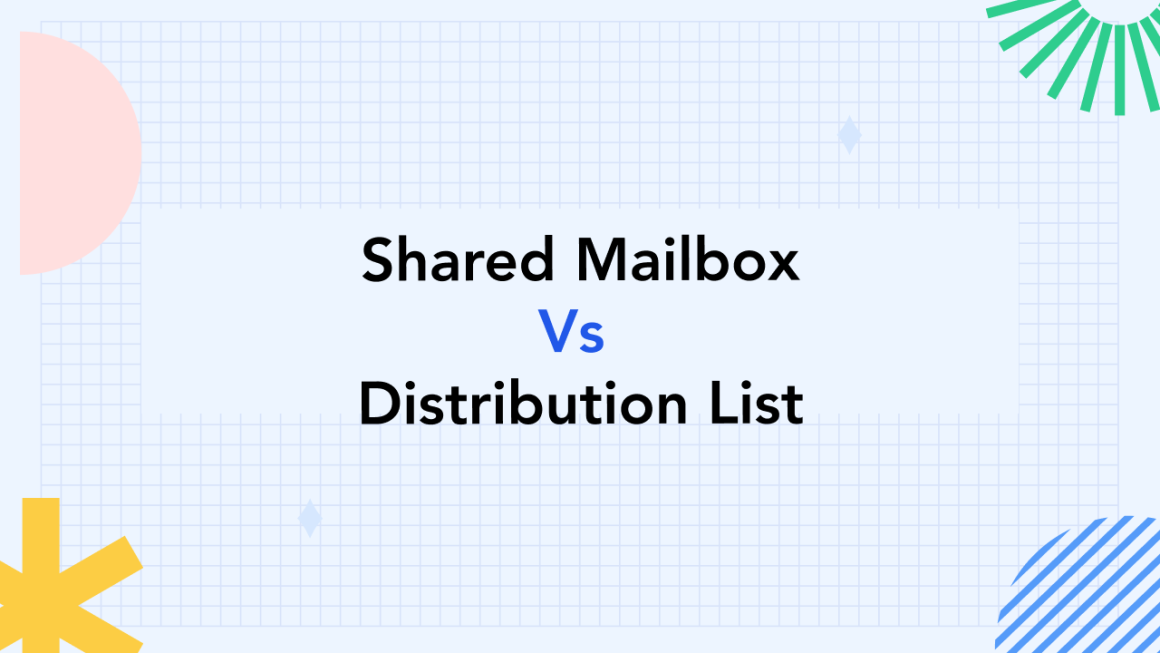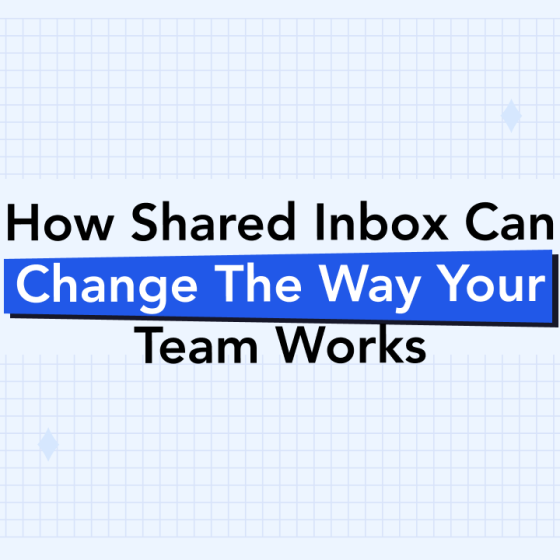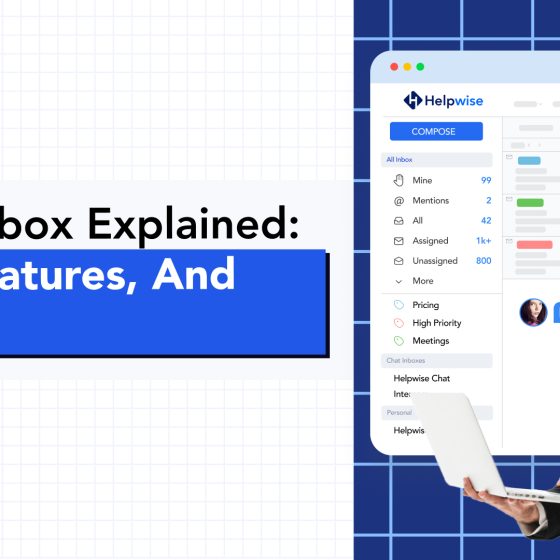With a constantly growing customer base, using a personal email address and CC’ing your support agents in message threads is no more an option. You need a more efficient email management solution.
That’s how you’ve found yourself choosing between a shared mailbox or a distribution list for your team. The fact is they both come with pros and cons, and they also have rather different use cases. So, which is most suitable for your situation?
In this article, we’ll delve into the key differences of shared mailbox vs distribution list, their respective benefits and drawbacks, and real-world use cases to help you make an informed decision for your business.
What is a shared mailbox?
A shared mailbox acts as a centralized email account that multiple team members can use to access, send, and receive messages. This feature is only accessible in Outlook — other email service providers also allow collaborative inbox management, but the setup process is slightly different for each platform.
Shared mailboxes can also provide a joint calendar and thereby allow multiple users to schedule and view vacation time or work shifts. All members can view incoming emails, reply on behalf of the shared mailbox, and access previous conversations, ensuring transparency and streamlined collaboration.
Teams can manage shared mailboxes both from PC and mobile devices.
Adding a shared mailbox on a mobile device.
What are the disadvantages of a shared mailbox?
Undoubtedly, a shared mailbox helps to increase transparency in the organization and builds a ground for more effective internal and external communication. But it comes with certain drawbacks:
- Limited personalization and accountability: Replies from a shared email address might lack a personal touch, leading to a less engaging customer experience. Additionally, it can be difficult to assign responsibility or accountability for specific emails or tasks when multiple team members have access to the same mailbox.
- Email management complexity: As the number of team members using the shared mailbox grows, email management can become complex. Duplicate replies or conflicting responses may occur if team members are not well-coordinated, leading to confusion in resolving customer queries.
- Access control challenges: Balancing security and granting appropriate access to team members requires careful consideration.
- Lack of advanced collaboration features: Outlook’s shared mailbox is primarily designed for email communication and lacks advanced collaboration features found in dedicated collaboration platforms. For example, you can’t access task management, file sharing, and real-time chat features in a shared mailbox.
Need team inbox collaboration features? Helpwise offers omnichannel inboxes in a centralized platform. You can access automation rules and auto-assign features, have complete control over your inbox access permissions, and manage Outlook, Gmail, WhatsApp, calls, SMS, and social media inboxes in one place.
When should you use a shared inbox?
When is setting up a shared inbox a good idea? Here are the most common reasons for implementing a shared mailbox.
1. Customer support and help desk
Shared mailboxes are a great choice for customer support teams, as they allow multiple agents to access and respond to customer inquiries from a centralized location. With a shared mailbox, incoming customer emails are visible to all team members, eliminating the need for forwarding or manual distribution.
The drawback of this use case though is limited opportunities for building a personal connection with customers.
2. Prioritization in customer service
A shared mailbox offers a simple yet powerful solution for organizing work within customer service teams by allowing them to create tags and folders to categorize incoming emails effectively.
Customer service teams can group emails into different categories based on the nature of the inquiry or the priority level. This way, agents can quickly identify and prioritize tasks, ensuring that each email is appropriately assigned to the most relevant team member.
3. General information address
Some organizations use a shared mailbox as a general contact address for inquiries, feedback, or requests. This approach works well if you don’t have dedicated email addresses for different types of requests or if you want to have an overview of all brand communications in one inbox.
But, what is the difference between a shared inbox and a distribution list? Well, worry not! We have got all your answers.
What is a distribution list?
A distribution list is a feature that allows to create a static list of email addresses to send out mass messages. Outlook has recently renamed the feature to a contact group.
When an email is sent to the distribution list’s address, the email server automatically forwards a copy of the message to all the members listed in that distribution list.
It enables the sender to reach multiple individuals with a single email, making it a convenient and efficient way to disseminate information, announcements, or messages to a predefined group.
Can a distribution list send email?
Contrary to what other articles say, members of a distribution list can reply to emails sent to distribution lists in Outlook. It can be done with the user’s email address or the distribution list address.
Sending an email to a contact group, a.k.a. distribution list.
What are the disadvantages of a distribution list?
When using distribution lists, you should be ready to face the following complications:
- The need for frequent updates: Keeping distribution lists up to date is a challenge, particularly in dynamic organizations with frequent personnel changes. Every team that uses distribution lists has experienced communication gaps at least once because a sender has forgotten to include a new member in the list.
- Confusion. When an email is sent to a distribution list, any recipient can reply to all, causing email threads to grow rapidly and potentially leading to unintended recipients receiving responses that may not be relevant to them.
- Email overload: When a member of the distribution list replies to the email, all other recipients receive a copy of the response. If multiple recipients reply, this can quickly result in a flood of emails, making it challenging to manage and respond to all the incoming messages effectively.
When should you use an email distribution list?
Here are the most frequent use cases of distribution lists in customer service.
1. Team-wide announcements and updates
Distribution lists are ideal for disseminating important customer service-related announcements, policy changes, and updates across the entire customer support team. Whether it’s new protocols, service enhancements, or company-wide initiatives, using distribution lists ensures that all customer service agents receive critical information simultaneously, fostering a cohesive and well-informed team.
2. Customer communication and updates
Customer service teams can use distribution lists to reach out to customers with relevant updates or important announcements. Whether it’s a service outage notification or an upcoming product release, using distribution lists enables businesses to keep their customer base informed.
3. Agent training
When conducting training sessions, workshops, or e-learning programs, companies often use distribution lists to communicate with enrolled employees. This includes sending training materials, schedules, reminders, and additional resources to support the learning process.
The difference between a shared inbox and a distribution list
So, a shared mailbox or a distribution list?
While distribution lists focus on sending emails to a group of recipients, shared mailboxes are more collaborative in nature, allowing multiple users to access and manage a shared email account, often used for tasks like customer service or project coordination.
The biggest difference between a shared inbox and a distribution list is that a shared mailbox is best for managing inbound communications, and a distributed list is mostly used for internal and outbound communications.
Both distribution lists and shared mailboxes are valuable tools, and the choice between them depends on the specific needs of your customer service team. For instance, if your customer service team primarily deals with inbound customer inquiries and requires a unified platform to manage and respond to these messages efficiently, a shared mailbox is an excellent fit. On the other hand, a distribution list — as its name suggests — is best for distributing outbound messages.
Answering these questions will help you make a final decision on which one to choose for customer service:
- Scalability: How well does each option adapt to the changing needs of your business as it grows?
- Security and privacy: What level of control over sensitive information do you want to have? Which one is more important for you: transparency or security?
- Collaboration and productivity: Which solution enhances teamwork and ensures smooth coordination among team members?
- Maintenance and management: Which option is easier for you to set up and manage in the long run?
Now, we hope you know which one to use – a shared mailbox or a distribution list.
Signs that change is needed
How do you know whether you’ve made the right choice? The only benchmark is the experience of your employees and customers.
These are troubling signs that your current email communication setup needs revisiting:
- Customers follow up on emails when they never got a reply after a few days.
- Team members reply to the same customer email with duplicate or conflicting input.
- You don’t know who was managing a customer support issue, and it takes some investigating to find the user and the solution they offered.
- You have no reporting insights into the volume of emails you get, how fast your team replies, who’s replying to what, or how satisfied your customers are with the answers they’re reading.
- Collaboration is challenging. There is no clear way to assign things to particular users or add notes and comments without sending those emails to different teammates.
The best shared mailbox management solution
Both shared mailboxes and distribution lists offer valuable use cases for streamlining communication within organizations. While shared mailboxes facilitate collaboration and handle customer support, distribution lists help to disseminate information to predefined groups.
However, neither of these options offers advanced collaboration features and the ability to scale communications effectively. Shared mailbox management software like Helpwise allows you to centralize all customer and internal communications in a collaborative space.
Helpwise acts as a centralized hub where team members can collaborate, assign tasks, and reply to emails, significantly improving project coordination and productivity. Book a free demo to learn more about Helpwise.










